Few games among the Nintendo Switch 2 launch line-up can match Cyberpunk 2077 in putting the system through its paces. It’s a staple of our PC benchmarking suite for good reason: the open world design is a solid stressor for any CPU, while its effects-heavy battles challenge GPU resources as well. This Switch 2 release has clearly been a big undertaking for developer CD Projekt Red too, who produced the port in-house with unique optimisations for Switch 2’s ARM-based architecture. It’s also remarkably the Ultimate Edition of the game, with both the core adventure and the more taxing Phantom Liberty expansion bundled in – an extra portion that proved too demanding to justify a last-gen console release, and was instead restricted to PS5 and Series X/S, and yet here it is running on Switch 2.
To cut to the chase, Switch 2 offers a truly viable way to enjoy Cyberpunk, either in a portable format or docked under a TV. However, CDPR has shot for the stars in its ambition to include Phantom Liberty as well, and it’s here that Switch 2 hits some technical limits – with frame-rates struggling as we explore its newer Dog Town region. Still, that aside, there’s a lot to admire in the game’s engineering for Nintendo’s new console overall, and how competitive it is in comparison with other consoles.
With that in mind, where exactly does Switch 2 slot in visually between the last-gen PS4 and the more advanced Xbox Series S and PS5 versions? And what’s the state of its frame-rate as it targets 30fps in its quality mode or 40fps in its performance mode? Let’s find out.
First up, Switch 2 actually offers four main configurations, with a 30fps quality mode and 40fps performance mode on offer in both docked TV or portable play. The biggest point of differentiation between each mode is image quality. Switch 2 is the only console to offer Nvidia’s DLSS upscaling, albeit in a custom form, versus the FSR on PS5/Series consoles and CDPR’s TAA on last-gen machines. In docked play, each mode targets 1080p via DLSS, with quality mode rendering at a resolution between 720p to 1080p and performance mode operating at a more flexible 540p to 1080p to sustain 40fps. Inevitably, Switch 2 in its portable state drops these figures further, down to a 450p to 810p range in quality mode (targeting 810p via DLSS), and further still with a 360p to 720p range in performance mode (reconstructing to 720p via DLSS).
It’s no surprise to see these resolutions scale so aggressively for portable play. After all, Switch 2’s Tegra T239 GPU clock speeds drop from 1GHz while docked to just 0.56GHz in its portable state, and something has to give. For static shots, DLSS normally does a great job in transforming the raw pixel input of each mode into a sharp, clear result, but heavy action with lots of motion pushes the tech to its absolute limits. Racing through Night City’s busy streets, for example, the image is notably blurrier, it’s easier to catch bocking artefacts, and temporal noise is in clearer view along cable lines overhead.
The good news is that, outside of resolution, there are very few differences between docked and portable play in terms of core visual settings. Using video capture from the Switch 2 itself while played as a portable, we get a good e nough look at all modes in comparison despite its 1080p30 encode. Shadows, textures, SSR and world draw are closely matched no matter how you play: docked, portable, quality mode, performance mode all present identically. The only catch is that reflections in mirrors take a hit in clarity while using the performance mode in either state, but otherwise the world detail is consistent across the board.
With that in mind, how does Switch 2 compare to other consoles? In some respects the Switch 2 release is like no other: notably in its use of DLSS, but also its unique method for rendering shadows. In other respects, it borrows settings from both last and current-gen consoles to create a hybrid setup that best suits the system’s specs.
To start with the advantages first, Switch 2 runs at the same texture quality setting as PS5. Impressively, the availability of 9GB of usable RAM gives it the freedom to present ground textures, decals on walls, and clothing at an equivalent setting to base PS5 in most cases. In a broader comparison, Switch 2 often pushes beyond the last-gen PS4 and even Xbox Series S in this aspect, with both running at lower presets that chop texture map quality to fit within the 5.5GB or 8GB RAM available to devs on their respective systems. In fairness, many textures are universal in quality between all four consoles but, where there is a difference – like the freckles and stubble on Jackie’s face – Switch 2 uses higher setting than Series S.
The second win for Switch 2 is in image quality. The move to DLSS here reaps huge rewards next to PS4, which renders at a range of 720p to 900p with CDPR’s TAA. Fine details like rain resolve with greater sharpness against the dark night sky, plus there’s less obvious banding artefacts on fences as characters pass by in the foreground. In short, the DLSS method on Switch 2 is more adept in interpreting the details it wants to keep in place, while de-noising the image where there’s obvious artefacts. Notably, Cyberpunk’s screen space reflections suffer from a grainy, shimmering artefact on base PS4, which is nicely cleaned up via DLSS to create a more stable result on Switch 2. To sweeten the deal, it also resolves distant detail – foliage, buildings – with greater clarity in motion.
Even when compared to Series S on its own 30fps quality mode – rendering at 1440p – Switch 2 remarkably holds its own by virtue of its better upscaling. Again, artefacting on SSR is cleaned up, and the image is sharper in static moments next to the Series S release. However, there are instances where the lower base resolution gets the better of Switch 2, resulting in more aliasing on hard edges. There are limits then, but it’s impressive that Switch 2 is capably trading blows with Series S, and even at times surpassing it.
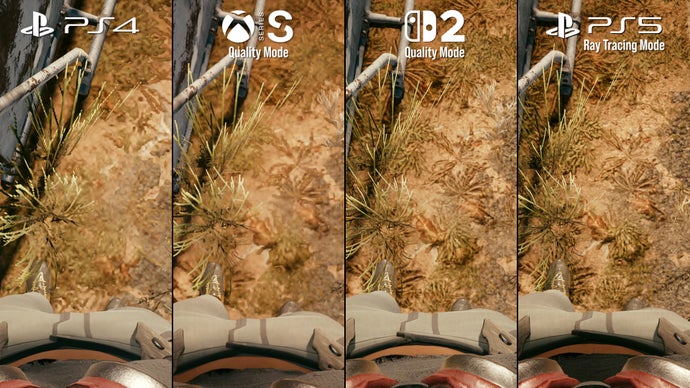
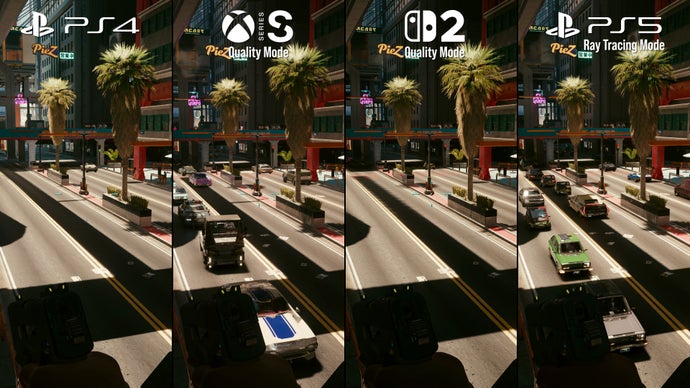
Next along, in terms of streaming in the complex detail of Night City – its market stalls, shop fronts and NPCs – Switch 2 is a far better optimised release than PS4. It benefits from higher bandwidth access to its internal storage (or expandable storage via Micro SD Express), whereas PS4’s creaky mechanical HDD is often a bottleneck in allowing key details to appear in good time. Admittedly, while stood still, the basic level of detail is comparable between the two machines. The real stressor is in sprinting or driving at pace, where the PS4 is often painfully slow to load textures, geometry, or crucial collision logic in bustling areas. It’s possible to wait 20-30 seconds for some of these elements to render in, and it genuinely affects playability to this day. Switch 2, on the other hand, plays out a lot closer to the Series S release in avoiding such visible pop-in, and consistently draws world assets in on time.
For all its advantages, Switch 2 does have some limitations too. Let’s start with a big one: NPC and vehicle density are roughly on par with the base PS4 version. It’s still very respectable, but it essentially means that traffic in Night City is less likely to build up to outrageous gridlock levels, while market crowds have a similar density to last-gen. By comparison, PS5 and Series S use a higher setting for both NPC and vehicle density, often filling its roads with more bustling activity. It’s a concession for Switch 2 that almost certainly caters to a CPU limit that might otherwise cause some turbulence to its 30fps (or 40fps) cap. Still, what Switch 2 achieves here is impressive.
The second limit relates to shadow rendering. Switch 2 appears to use a unique setting, with interior shadows notably improved on Switch 2 vs PS4, with sharper character silhouettes from spotlights. But, conversely, outdoor shadows projected from the sun are a step back from the PS4 version in their overall effect. The result is that there’s a less stable, more pixellated, look to shadows on Switch 2, such as those stemming from trees overhead. Likewise, shadows from pixel-thin details, like metal bars or barbed wire, also suffer from using a low resolution form of the effect outdoors. Finally, a more obvious filtering cascade is also visible on Switch 2, adding stippling to long shadow lines stretching far to the distance. Ultimately Switch 2 falls short here, and certainly lacks the precision of Series S and PS5’s shadow setting while outdoors.
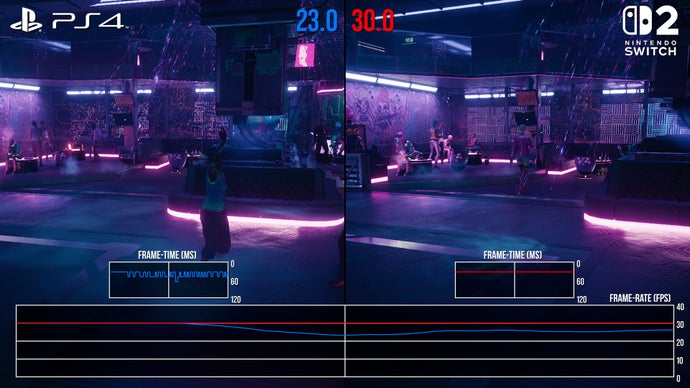
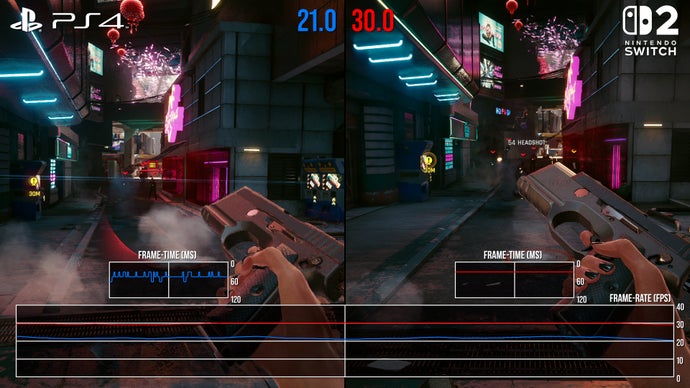

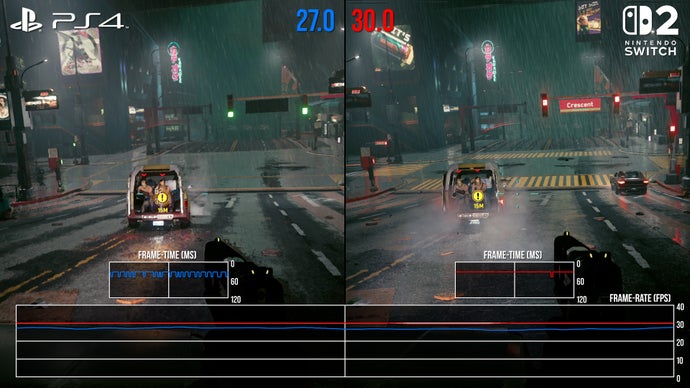
Looking to performance, Switch 2 makes good on its promise of hitting 30fps in its quality mode. For the main Cyberpunk adventure at least, including most driving or shoot-outs in the first Maelstromers mission, it conforms to an evenly frame-paced 30fps cap. Odd frame drops are possible, but it’s rarely egregious enough to detract from the experience. Next to PS4 in the same stress test areas, it’s hugging the 30fps line for a majority of play, where too often PS4 falls closer to 20fps. Without doubt, this is a clear Switch 2 win in overall playability, and crucially it avoids many of the frame-time spikes seen on PS4 due to streaming bottlenecks.
There are ways to brute-force the RED Engine into drops of course, not least our classic alleyway shoot-out test. Even in this case though, Switch 2’s worst reading briefly goes to 28fps, while PS4 drops take us well under 20fps. For an even more extreme test, accelerated driving through the Kabuki region is a sure-fire way to trigger major drops, and here Switch 2 shows a real limit: a sustained mid-20s reading similar to PS4’s, with a traversal hitch or two for good measure. Still, this represents the very worst case in the base game, and Switch 2 is significantly ahead of PS4’s reading in every scenario.
Next along, the Phantom Liberty expansion presents a much greater technical hurdle for Switch 2. Sadly, this is where we see the flip-side to the Switch 2 version – and it does fall short of Series S’ often stable 30fps reading. In short, from our first landing in the Dog Town area, sub-30fps drops are much more abundant. Low points include an early shoot-out with multiple enemies, a run through its slums area, and also a drive down its besieged streets. Each moment sees a sustained drop into the mid-20s on Switch 2 – and lower – while Series S comfortably clears 30fps through it all. Worst of all, Switch 2 has frame time hitches in excess of 120ms while driving here, which makes driving a genuine challenge. This helps to demonstrate why this expansion was never released on last-gen consoles; clearly for Switch 2, Phantom Liberty’s more complex design makes 30fps a taller order. Of course, re-testing the core Cyberpunk game against Series S makes for a less stark divide: Series S clears up the Kabuki stress test and the alleyway shoot-out at 30fps, but otherwise, both run at a matching 30fps in most areas.

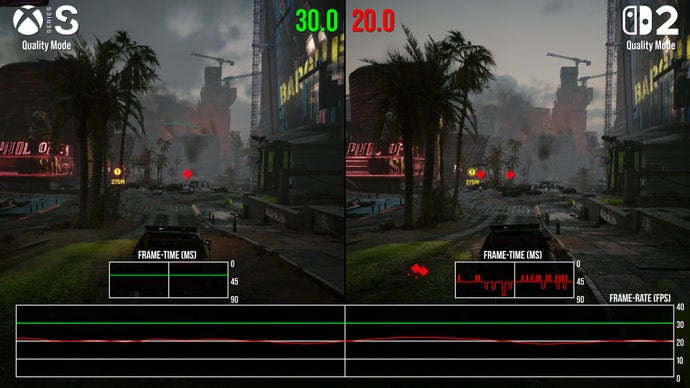
The state of Switch 2’s 40fps performance mode is less convincing. This requires a 120Hz compatible TV to access and offers a 25ms frame-time target that’s exactly half-way between 30fps (33.3ms) and 60fps (16.6ms). Unfortunately, Switch 2’s 40fps delivery has rather mixed fortunes. In simpler interior areas where it does hold at 40fps, it’s unquestionably a smoother experience, but shoot-outs and driving tend to drop to 30fps or below. Compounding the issue, there’s no VRR support to TVs during docked play either, so these drops stick out obviously to the naked eye. In comparison to the more stable 30fps quality mode, it’s hard to really see the benefit of this mode, as the performance mode reading wavers above and even below 30fps quite erratically. Even though we’re stuck with a 33.3ms render time on quality mode, it turns out that 30fps is simply a more realistic, dependable target for the system to hit in docked play.
Happily, Switch 2’s performance in portable play offers frame-rates broadly equivalent to the docked experience. The lowered resolutions here help to a sufficient enough degree to keep 30fps in view, though the Kabuki drive test and the Phantom Liberty expansion remain clear rough spots. We can’t test this with our usual tools, given that capture is limited to the compressed 30fps video generated by Switch 2 itself, but it’s still clear that that the 40fps performance mode works well on the Switch 2’s 120Hz VRR display. VRR helps considerably to minimise the perceptibility of drops under 40fps and it’s the smoothest way to enjoy the game on Switch 2 as a result. However, there’s no low frame-rate compensation (LFC) to extend the VRR range below 30fps, so frame-rates below this mark result in visible judder once again. Still, the performance mode makes much more sense in portable play.
Through all its pros and cons, Cyberpunk 2077 on Switch 2 is a very playable rendition of CDPR’s latest work – and a showcase of the system’s technical prowess to a degree that’s ambitious for a launch title. As an added bonus, the Switch 2 release even has unique extras, most notably Joy-Con mouse controls and even (undocumented) plug-and-play USB mouse and keyboard support. The performance issues in the Phantom Liberty portion are unfortunate, but they are at least overshadowed by the quality of the core Cyberpunk campaign. We get a hybrid of last and current-gen console settings here, with Switch 2 somehow even exceeding Xbox Series S in texture quality. On balance then, it’s an encouraging start for taxing open world efforts on Nintendo’s new hardware, and we expect it’s the first of many to come.
